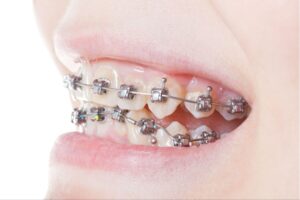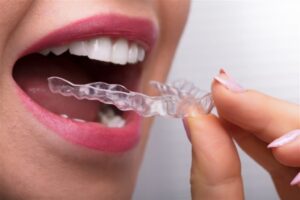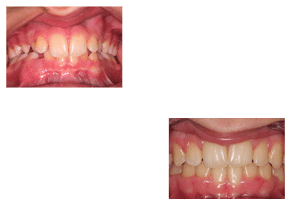Choosing Invisalign or braces for your teen isn’t always a simple decision. Each option comes with its own benefits and challenges, and the choice can have a big impact on your teen’s day-to-day life. From school activities to confidence in social settings, the treatment you pick should support their lifestyle and long-term dental health.
Parents often ask what will work better, look better, or be easier to manage. Teens may care more about how it looks or feels. It’s not just about straight teeth—it’s about choosing a method that fits your family’s priorities and your teen’s needs. Compare both options clearly so you can make a confident choice.
What Are the Main Differences Between Invisalign and Braces?
When comparing Invisalign or braces, it’s important to first understand how each treatment works and what makes them different.
Braces
Braces use metal or ceramic brackets that are glued to the teeth. Wires are threaded through the brackets and adjusted by the orthodontist at regular appointments. These adjustments help shift the teeth into place over time.
There are several types of braces available:
-
Metal braces: The most traditional and often the most affordable.
-
Ceramic braces: Tooth-colored and less noticeable, but more fragile.
-
Self-ligating braces: Use clips instead of rubber bands, which may reduce friction.
Since braces are fixed to the teeth, they’re always working. But they also come with more visible hardware and require attention to cleaning and food choices.
Invisalign
Invisalign is a system of clear plastic aligners that are custom-made to fit the patient’s teeth. The aligners are changed out every 1 to 2 weeks as the teeth move gradually into their new positions.
Unlike braces, Invisalign is:
-
Removable for eating, drinking, and brushing.
-
Made of smooth, clear material that is barely noticeable.
-
Typically used for mild to moderate orthodontic issues.
Treatment success depends on wearing the aligners for 20–22 hours a day. Teens who lose or forget to wear their trays may slow their progress.
Pros and Cons for Teenagers
Choosing Invisalign or braces depends on several factors, including comfort, appearance, treatment duration, and lifestyle. Each option offers distinct advantages and disadvantages. Here’s a breakdown of what you can expect from both treatments.
Braces Pros
-
Effective for Complex Cases: Braces are ideal for more severe orthodontic issues, such as crooked teeth, bite misalignments, or jaw problems. They provide precise control over tooth movement.
-
No Risk of Losing Braces: Since braces are fixed to the teeth, there’s no chance of misplacing or forgetting about them, which can sometimes happen with removable aligners.
-
More Common Insurance Coverage: Traditional braces are often better covered by insurance plans compared to Invisalign, especially for teens. This can make braces a more budget-friendly option.
-
Works for All Ages: Braces are suitable for both children and adults, making them a versatile treatment for people at various stages of life.
Braces Cons
-
Noticeable and Visible: One of the most obvious drawbacks of braces is their visibility. Teens who are self-conscious about their appearance may not feel as confident wearing them, especially in social situations.
-
Discomfort and Mouth Irritation: Braces can cause discomfort, particularly after adjustments. The brackets and wires can irritate the inside of the mouth, leading to sores or cuts.
-
Food Restrictions: With braces, certain foods like popcorn, hard candy, or sticky snacks need to be avoided to prevent damage. These food restrictions can be inconvenient for some teens.
-
Regular Appointments: Braces require frequent visits to the orthodontist for adjustments, which can be time-consuming.
Invisalign Pros
-
Virtually Invisible: The clear plastic aligners make Invisalign nearly invisible, which is a big advantage for teens who don’t want to draw attention to their orthodontic treatment.
-
Removable for Meals and Cleaning: Invisalign trays can be taken out while eating or drinking, so there are no food restrictions. Plus, it’s easier to brush and floss, promoting better oral hygiene.
-
More Comfortable: Without metal wires or brackets, Invisalign is generally more comfortable, with fewer chances for mouth irritation.
-
Flexibility in Social Situations: Teens who are active in sports or social events may prefer Invisalign, as it doesn’t involve the discomfort and visibility of braces. Aligners are also less likely to interfere with speech.
Invisalign Cons
-
Discipline is Key: Invisalign aligners must be worn for 20–22 hours a day. Teens who forget or are not disciplined enough to wear them as instructed may experience delays in treatment.
-
Can Be Lost or Damaged: Since Invisalign trays are removable, there’s a risk of losing or damaging them. Replacements can add extra costs and delays.
-
Not Ideal for Severe Cases: While Invisalign is effective for mild to moderate issues, it may not be the best solution for more complex orthodontic problems that require more force and precision, like severe misalignment or bite issues.
How Treatment Time and Results Compare
When considering Invisalign or braces for teens, treatment time and expected results are key factors in making the right choice. Each option works at a different pace, and understanding the differences can help you set realistic expectations.
Average Treatment Length
-
Braces: Typically, braces treatment lasts between 18 to 36 months, depending on the severity of the orthodontic issue. For more complex cases, braces tend to work faster due to their continuous adjustments and precise control over tooth movement.
-
Invisalign: The average treatment time for Invisalign is often shorter, typically around 12 to 18 months for mild to moderate cases. Since aligners are switched regularly (usually every 1 to 2 weeks), the movement is gradual but consistent. However, for teens with more severe misalignments, treatment may take longer or require a combination of Invisalign with other dental treatments.
Compliance and Its Impact on Treatment Time
One of the biggest factors influencing treatment time with both options is how consistently the teen follows the treatment plan.
-
Braces: Since braces are fixed, they’re always working. Compliance isn’t an issue as long as the patient avoids food restrictions and maintains good oral hygiene. The treatment timeline remains fairly predictable.
-
Invisalign: Invisalign requires the teen to wear the aligners for 20 to 22 hours per day. If they’re not worn as directed, treatment can be delayed. Aligners should only be removed for eating, drinking, and cleaning. Missing even a few hours a day can add weeks to the overall treatment time.
Long-Term Results and Post-Treatment Care
-
Braces: Once the braces are removed, the teen will typically wear a retainer for a period to maintain the results. While braces are highly effective, keeping teeth straight long-term still requires effort, especially with the retainer. Many teens must wear their retainer nightly for several years to prevent regression.
-
Invisalign: Similarly, after Invisalign treatment, a retainer is needed to ensure the teeth stay in their new positions. The advantage of Invisalign is that many teens find it easier to wear the retainer regularly since it’s clear and comfortable. However, post-treatment retainer wear is crucial for both treatments to prevent teeth from shifting.
Comparing Results
-
Braces: Braces offer precise control and can correct a wide variety of orthodontic issues, including severe bite problems and misalignment. The results are generally more predictable and can be customized as the orthodontist adjusts the braces throughout the process.
-
Invisalign: Invisalign is most effective for mild to moderate cases, such as crowding or small gaps. It can be just as effective as braces when used for appropriate issues, but it may not work as well for more complex alignment problems. However, many teens appreciate the discreet appearance and the flexibility that comes with Invisalign.
Lifestyle Considerations for Teens
Choosing Invisalign or braces also involves understanding how each treatment affects your teen’s lifestyle. Teens are often involved in sports, social activities, and busy school schedules, so it’s important to consider how each option will fit into their daily routine. Here are some key lifestyle factors to think about:
Sports and Physical Activity
-
Braces: For teens who play contact sports, braces can pose a challenge. Brackets and wires can get damaged during a game, and they may cause injuries to the mouth if there’s a direct impact. Orthodontists often recommend wearing a mouthguard to protect both the braces and the teen’s teeth. However, this extra gear can feel uncomfortable for some teens.
-
Invisalign: Invisalign aligners are removable, which means they can be taken out during sports or physical activities. This reduces the risk of injury and discomfort. Teens can remove the aligners before a game or practice, and then put them back in afterward. The flexibility of removing the aligners during physical activity can be an advantage for more active teens.
School & Social Life
-
Braces: While braces are very effective, they can make teens feel self-conscious, especially in high school when appearance matters. The visible metal brackets and wires can affect their confidence, leading to social anxiety in some cases. Braces can also occasionally interfere with speech, particularly right after adjustments when the mouth may feel sore.
-
Invisalign: Since Invisalign aligners are clear and nearly invisible, they offer a more discreet treatment option. Teens can smile, speak, and interact without worrying about the appearance of their braces. Invisalign also allows them to remove the aligners for photos, which makes it easier for them to enjoy social events without the concern of having visible braces in pictures.
Diet & Hygiene
-
Braces: Braces come with dietary restrictions to avoid damaging the wires or brackets. Teens will need to avoid hard, sticky, or chewy foods like caramel, gum, and popcorn. These restrictions can be frustrating, especially for teens who enjoy snacks or have busy social lives centered around food.
-
Invisalign: One of the advantages of Invisalign is that the aligners are removable. This means that teens can eat whatever they want, as long as they remove the aligners first. After eating, they simply need to brush their teeth before putting the aligners back in. This flexibility is a big benefit for teens who don’t want to deal with food restrictions.
-
Hygiene: Brushing and flossing with braces can be tricky since food particles can get stuck in the brackets and wires. Teens must take extra care to clean their teeth thoroughly to avoid plaque buildup and cavities. Invisalign aligners are easier to maintain, as the aligners are removed while eating, and the teen can brush and floss their teeth normally. However, keeping the aligners clean is important to prevent odors and stains.
Cost and Insurance Considerations
When it comes to orthodontic treatment, cost is often a significant factor in the decision-making process. Both Invisalign or braces can be costly, but there are differences in pricing, insurance coverage, and potential hidden costs. Here’s what you need to know:
Average Cost of Treatment
-
Braces: The cost of traditional braces typically ranges from $3,000 to $7,000. The final price depends on factors such as the severity of the orthodontic issue, the type of braces (metal, ceramic, or self-ligating), and the length of the treatment. Complex cases that require more adjustments and longer treatment times can result in higher costs.
-
Invisalign: Invisalign treatment generally costs between $3,500 and $8,000, depending on similar factors—treatment complexity, the length of time needed, and the location of the orthodontist’s practice. However, Invisalign can sometimes be more expensive than braces, especially if the treatment needs to be adjusted or replaced due to poor compliance.
Insurance Coverage
-
Braces: Many dental insurance plans cover braces for teenagers, as they are considered the standard form of orthodontic treatment. If the insurance covers orthodontics, you may be able to claim a significant portion of the cost. Some plans cover the full cost, while others only offer partial reimbursement, which can still help reduce out-of-pocket expenses.
-
Invisalign: Invisalign may not be covered as widely by insurance plans. Although some insurance providers include Invisalign in their orthodontic coverage, others may classify it as an optional cosmetic procedure. It’s important to check with your insurance provider to see if Invisalign is covered, and if so, how much of the treatment cost will be reimbursed.
Hidden Costs
-
Braces: Although braces may be covered by insurance, there could be additional costs that aren’t covered by a typical plan. These can include:
-
Emergency visits: If a bracket or wire breaks, you may need to pay for an emergency orthodontic appointment to fix it.
-
Retainers: After the braces are removed, your teen will likely need to wear a retainer to maintain their new smile. Retainers are typically not covered by insurance.
-
Adjustments and Maintenance: While regular adjustments are included in the initial cost of braces, some orthodontists may charge extra for maintenance or adjustments outside the scheduled visits.
-
-
Invisalign: With Invisalign, there are additional potential costs:
-
Replacement aligners: If the aligners are lost or damaged, the cost of replacements may not be covered by insurance. This can add to the overall price of treatment.
-
Post-treatment care: As with braces, retainers will be necessary after completing Invisalign treatment to prevent teeth from shifting. Some retainers are included in the initial treatment price, but it’s worth confirming this with your orthodontist.
-
Financing and Payment Plans
-
Braces: Many orthodontists offer payment plans for braces, which can spread the cost over several months or years. These plans are often interest-free, but it’s important to confirm the details before committing. Some practices also offer discounts for paying upfront or for multiple family members undergoing treatment at the same time.
-
Invisalign: Invisalign also offers flexible payment plans, and some orthodontists may provide a sliding scale based on the cost of the treatment. Invisalign providers may also offer interest-free financing or monthly payments. It’s important to inquire about available financing options when considering treatment.
What Do Orthodontists Recommend for Teens?
When deciding between Invisalign or braces, consulting with an orthodontist is one of the best ways to get a personalized recommendation based on your teen’s specific dental needs. Orthodontists evaluate each case individually, taking into account factors such as dental health, the severity of the orthodontic issue, and the teen’s ability to comply with treatment requirements.
Professional Evaluation
Orthodontists are experts in diagnosing and treating misalignment issues. During a consultation, they will perform a thorough evaluation, which includes:
-
X-rays: To assess the alignment of teeth and jaws.
-
Impressions or Scans: To create an accurate model of your teen’s mouth, helping to determine the best treatment plan.
-
Dental History: Reviewing any past treatments or dental concerns that may influence the orthodontic approach.
Based on this assessment, the orthodontist will discuss the pros and cons of both treatments and recommend which option is likely to provide the best results for your teen. They’ll explain why one treatment may be better suited to your teen’s specific situation, such as how complex the dental issues are or how much the teen is willing to commit to the treatment.
Orthodontist’s Insights on Braces
Orthodontists often recommend braces for teens with more severe cases, such as:
-
Complex bite issues (e.g., overbite, underbite, crossbite)
-
Severe tooth crowding
-
Teeth that need significant movement
Braces allow for more precise control over tooth movement, making them the preferred choice for complex cases. Since braces are fixed to the teeth, they continue working even when the teen forgets to wear them, which can be a concern with removable aligners.
Orthodontist’s Insights on Invisalign
Invisalign is often recommended for teens who have:
-
Mild to moderate dental issues, such as minor crowding or gaps
-
A high level of responsibility and compliance, since the aligners must be worn for 20-22 hours per day
Invisalign is also a popular choice for teens who are concerned about the visibility of braces. Since the aligners are clear and removable, they offer a more discreet option, which can boost a teen’s confidence during treatment.
While Invisalign may not be ideal for complex cases, it’s a great choice for teens who prioritize comfort, appearance, and the ability to remove the aligners when necessary. The decision to go with Invisalign or braces ultimately depends on how well the teen is likely to follow the treatment plan and the specific dental concerns being addressed.
Consultations and Personalized Advice
Ultimately, the best recommendation comes from an orthodontist who knows your teen’s specific dental needs. Many orthodontists offer initial consultations to assess your teen’s case, discuss options, and provide insights on treatment. They will work with you to choose the best option for your family, ensuring that your teen gets the results they need with a treatment plan they can follow.
FAQs: Common Parent & Teen Questions
Choosing between Invisalign or braces can raise many questions for both parents and teens. Here are some of the most frequently asked questions that can help clarify the process and guide your decision-making.
1. Can Teens Switch from Braces to Invisalign Mid-Treatment?
In some cases, it is possible to switch from braces to Invisalign if the teen has made significant progress in their treatment. However, this is not always recommended, especially for complex cases. The decision to switch should be made in consultation with the orthodontist, who will assess the progress and determine if Invisalign can continue to address the treatment goals effectively.
2. How Often Are Invisalign Trays Changed?
Invisalign trays are typically changed every 1 to 2 weeks. Each new tray gradually moves the teeth into the desired position. It’s important for teens to wear the aligners consistently to ensure the teeth are shifting properly with each new tray. Missing days or not wearing the trays for the required amount of time can delay treatment and make the next set of aligners less effective.
3. Do Braces Hurt More Than Invisalign?
Braces can cause some discomfort, especially right after adjustments when the wires are tightened. This can lead to soreness in the mouth and teeth for a few days. On the other hand, Invisalign is generally considered more comfortable, as the aligners are smooth and don’t cause irritation to the inside of the mouth. However, the initial days after changing to a new aligner can also cause some pressure or discomfort as the teeth begin to shift.
4. What Happens if a Tray Is Lost?
If an Invisalign tray is lost, it’s important to contact the orthodontist as soon as possible. Depending on the stage of treatment, the orthodontist may suggest wearing the previous set of aligners until a replacement is made or they may provide a new set right away. Lost aligners can delay the treatment process, so it’s important to ensure the trays are kept in a safe place when they’re not being worn.
5. Are Ceramic Braces Less Noticeable Than Metal Braces?
Yes, ceramic braces are less noticeable than traditional metal braces. Ceramic braces use clear or tooth-colored brackets, making them a more discreet option. However, the wires that connect the brackets can still be visible, and ceramic braces tend to be more fragile than metal ones. For teens who want a less noticeable option but still need the power of braces, ceramic braces can be a good alternative.
6. Can Invisalign Fix Severe Cases Like Braces?
Invisalign is generally best for mild to moderate orthodontic issues. For severe cases, such as complex bite problems or significant misalignment, braces are usually recommended. Invisalign can be effective for cases that don’t require as much force to move the teeth, but more complex problems may require the more precise control that braces provide.
Final Thoughts: Which Is the Better Fit?
Choosing between Invisalign or braces ultimately comes down to your teen’s specific dental needs, lifestyle, and personal preferences. Both options offer effective treatment for straightening teeth, but the decision should be made carefully after considering factors such as comfort, appearance, cost, and treatment duration.
Key Takeaways
-
Braces are ideal for teens with more complex orthodontic issues, including bite misalignments or severe crowding. They offer precise control over tooth movement and can address a wide range of dental concerns.
-
Invisalign is a great choice for teens who want a more discreet option. It’s comfortable, removable, and works well for mild to moderate orthodontic issues. However, it requires discipline and consistent wear to be effective.
Consider What’s Best for Your Teen
When making this decision, consider your teen’s lifestyle and how they will manage their treatment:
-
How disciplined is your teen about wearing aligners consistently (if choosing Invisalign)?
-
Are they active in sports, and would the flexibility of removable aligners be a better fit for their needs?
-
What is the level of comfort and appearance they are looking for during their treatment?
If you’re unsure, the best step is to consult with an orthodontist who can provide personalized recommendations based on your teen’s dental health and treatment goals.
Take the First Step Toward a Perfect Smile
At Monmouth Ocean Orthodontics, we specialize in creating beautiful, confident smiles. Whether you're considering Invisalign or braces, our expert team is here to help you choose the best treatment for your unique needs. We use the latest technology and techniques to make your orthodontic experience as comfortable and efficient as possible.
Don't wait any longer to start your journey to a healthier, more radiant smile. Contact Monmouth Ocean Orthodontics today to schedule your consultation and find out how our customized treatment plans can give you the smile you’ve always wanted.







